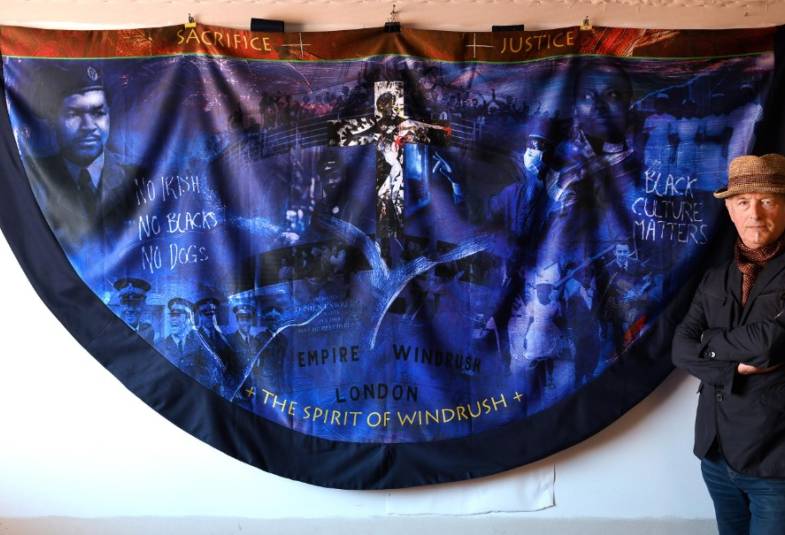21/06/2018

A specially-commissioned ceremonial robe which tells the story of life in Britain for the Windrush generation and their descendants is to be worn for the first time at the Westminster Abbey service commemorating the Windrush 70th anniversary.
The cope (a robe, or vestment used by clergy at special services or occasions) created by internationally renowned artist Terry Duffy will be worn by the Dean of Westminster, The Very Rev Dr John Hall, at Friday’s service in Westminster Abbey.
The vestment features a photo montage illustrating aspects of black history in Britain since the arrival of the MV Empire Windrush on June 22 1948, including the original 1948 ‘British citizen’ passport issued to Alford Gardner, a passenger on the ship, and an image of Sam King, another of the ship’s passengers, who later became the first black Mayor of Southwark. The image of the Jamaican-born Chaplain to the Speaker of the House of Commons, Rev Rose Hudson-Wilkin is also included.
The photo montage makes reference to the murder of Stephen Lawrence and alludes to racial discrimination faced by Caribbean migrants in post-war Britain including the sign ‘No Irish, No blacks, No dogs’ a familiar notice displayed in the windows of some boarding houses with rooms for rent.
The ‘Windrush’ cope was commissioned by the Church of England’s National Committee for Minority Ethnic Anglican Concerns and will be available on request to churches and clergy across the country after the service.
Dr Elizabeth Henry, the Church of England’s adviser on race and ethnicity, said: “We are thrilled that the Windrush cope will be worn for the first time at the Windrush 70th anniversary service in Westminster Abbey by the Dean of Westminster, Dr John Hall.
“The service is a moment when as a nation we remember the Windrush generation and the huge contribution made by so many who responded to the call to come and help rebuild post-war Britain.
“The powerful images on this Windrush cope provide testimony of both achievements made and discrimination experienced by those who made their home in this country; it is a vivid expression of the resilience and integrity of Windrush generations.
“In the future, we hope that this unique cope will be a catalyst to advancing thought, dialogue, debate and action in the wider Church on issues of racial justice and to remember the outstanding impact of the ‘Windrushers’ to British life and culture in decades to come.”
The Dean of Westminster, The Very Rev Dr John Hall, said: "I am delighted to be holding in the Abbey this very special service at which we thank God for the arrival 70 years ago of the ‘Windrush generation’.
"The enrichment of our national culture and life through the contribution made by so many people who have come here from the Commonwealth and elsewhere forms a major part of our celebration and thanksgiving.
"For me personally it is a great privilege to wear the ‘Windrush cope’ and to be reminded of the suffering and the achievement of so many who are now a vital part of our national story."
Terry Duffy said: “It was a great honour to be invited to create ‘The Windrush Cope’ and to be part of an event that commemorates the sacrifice and outstanding contribution made by the Windrush generation to British culture. Let us hope that this year is pivotal in achieving the racial equality they have so long fought for and deserve.”
Notes to the editor
Please credit pictures of artist Terry Duffy in front of the cope: Stephen Dodd / bigcheese.co.uk
Terry Duffy is an award-winning artist who has exhibited in London, Paris, Berlin, Philadelphia, New York, Cape Town, Liverpool and the 2009 Venice Biennale. For more information, see terryduffy.info.
Terry Duffy's previous works include the Coventry-Dresden Cope and painting. The Windrush cope was developed from an initial large-scale painting by Terry Duffy. In collaboration with photographer Mark Howard, it was digitally integrated within the photomontage and then printed on fabric and finely tailored into a vestment. The shape of the cope was inspired by the early English copes in the Victoria & Albert museum.